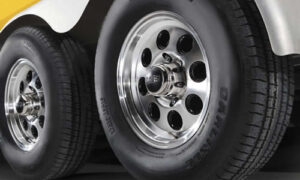

Driving in winter, especially storm conditions can be stressful at best and dangerous at it’s worst. More accidents involving property damage occur during the winter months than at any other time. You can minimize the stress and chances of wintertime accidents if you follow these winter RV driving tips.
Prepare Your Vehicle for Winter Driving
- Have the battery and charging system tested. A fully charged battery in good condition is required to start an engine in cold weather.
- Have the brakes checked to ensure they work properly and apply smoothly, this helps prevent the wheels from locking on slick roadways.
- Make sure the tires are properly inflated. Under-inflated tires can be dangerous and may suffer damage. Remember, the air pressure in your tires will decrease 1-2 psi for every 10-degree drop in outside temperature.
- Use the tire size recommended by your vehicle’s manufacturer for the best snow traction. Overly wide tires tend to float on top of the snow, reducing grip.
- Make sure the engine coolant provides anti-freeze protection down to the lowest temperatures you are likely to encounter; -30 degrees F/-34 degrees C is a good guideline.
- Visibility is critical in adverse weather conditions, so replace worn windshield wipers that streak, and be sure the washer reservoir is filled with a winter solvent that will not freeze.
- Keep the gas tank at least half full at all times to minimize condensation buildup that can lead to gas line freeze-up. If the fuel in your area does not already contain alcohol, use a gas line ‘dryer’ additive periodically to absorb moisture.
- Carry a winter driving kit for use in the event of an emergency. The kit should include a small bag of abrasive material (sand, salt, cat litter), a small snow shovel, a snow brush, traction mats, a flashlight with new batteries, window washer solvent, an ice scraper, a cloth or roll of paper towels, jumper cables, a blanket, warning devices (flares or triangles), drinking water and extra clothes.
- Program your radio for AM 530 or 1610 stations, as you may see signs referencing those frequencies for important traffic advisories.
- Have a cellular phone car charger.
- Program your phone with important numbers including your roadside service provider.
Plan Your Trip
If your plans include travel out of your local area it is important to plan your route ahead of time.
- Allow extra time to reach your destination. Delays are likely so if you plan for them you won’t stress about being late.
- Consider traveling on major highways and interstates since heavily traveled roads will be cleared or treated first during storms.
- Plan secondary routes in case your primary route is closed.
- Plan your fuel, food and rest stops.
- Have up-to-date, accurate maps, including on your GPS device.
- Your maps should include seasonal road closures and provide routing
- Don’t rely solely on your GPS for driving directions. We’ve all heard the stories of people getting directed onto dirt roads to nowhere. It’s an inconvenience in good weather but can be deadly in a winter storm.
- Manually review the routing directions provided by your GPS device or web-based routing service by checking maps and satellite views etc.
Winter RV Driving Tips
When driving during winter weather, remember to drive with caution to help maintain your safety and following these winter RV driving tips.
- If weather conditions are bad delay your trip, stop early for the day, or take an extended break from driving. You did allow extra time, right?
- Before starting out in snowy weather, take time to remove the snow from the entire vehicle so it doesn’t blow onto your windshield or the windshields of other drivers.
- Make sure your mirrors and lights are clean.
- Drive with your low-beam headlights illuminated.
- When the roads are icy, slow down and Allow sufficient room for maintenance vehicles and plows, stay at least 15 car lengths (200 feet) back and, if you need to pass, go to the other vehicle’s left.
- Watch for icy surfaces on bridges, even when the rest of the road seems to be in good condition.
- If you get stuck in the snow, straighten the wheel and accelerate slowly. Add sand or cat litter under the drive wheels to help avoid spinning the tires.
- If your tires lose traction, continue to look and steer in the direction you want to go. If the drive wheels start to spin or slide while going up a hill, ease off the accelerator slightly and then gently resume speed.
- Look farther ahead in traffic. Actions by other drivers will alert you to problems and give you extra seconds to react.
- When changing lanes, avoid cutting in front of trucks, which need more time and distance than passenger vehicles to stop.
- Don’t use cruise control in precipitation and freezing temperatures.
- Apply constant, firm pressure to the pedal with anti-lock brakes.
You may also be interested in the articles:
Cold Weather RVing Tips
Tips for Winterizing Your RV







